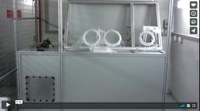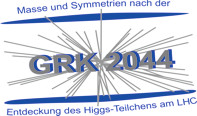Low Background
Experiments searching for rare events, such as for interactions from dark matter particles, need to have exhibit a radioactive background as low as possible. This background comes from various sources:
- Natural radioactive contaminations (mainly U, Th, K) in the detector construction materials (enclosure, cables, etc), leading to gamma-rays as well as neutrons (from (α,n)-reactions and spontaneous fission).
- Alpha, beta, or gamma-backgrounds from the detector material itself.
- Gamma- and neutron background from the experimental environment (laboratory walls, etc).
- Muons, (muon-induced) neutrons, or hadronic cosmic rays from the Earth's atmosphere.
There are various methods to reduce or even eliminate (the latter is usually not possible completely) each of these sources. These include the selection of very radio-pure materials to build the experiment, and placing it in deep-underground laboratories. Our group has access to the medium-depth Vue-des-Alpes laboratory in Switzerland and performs experiments at LNGS (Italy), the largest underground laboratory in the world.
Besides the low background, detectors to search for rare events are very special devices which are highly optimized to address specific scientific questions.
We work on several topics in order to make dark matter detectors better in various aspects.
- Gamma ray spectroscopy: We operate the low-background gamma spectrometer GeMSE (Germanium Material and Meteorite Screening Experiment) in the Swiss Vue des Alpes underground laboratory. The facility is used in an interdisciplinary way: to examine meteorites and to identify and select materials and components for low-background experiments.
- Rn emanation chamber: We have built the radon emanation detector MonXe to measure the radon (Rn) emanation rate of materials. The noble gas Rn is emitted from surfaces and can make it into the dark matter target producing critical backgrounds. MonXe is used to identify clean materials.
- LXe Detectors: We use Xebra, a small-scale (but extendable) liquid xenon detector in the laboratory in Freiburg to measure properties of liquid xenon, which is used as a target for our dark matter detectors, and to improve current detectors.
Both systems, the Xebra and GeMSE are operated and controlled by Doberman, a flexible Slow Control application developed for small and medium-scale projects. - Background reduction: We conduct several projects aiming at reducing or understanding possible backgrounds for low-background detectors. Examples are the study of cosmogenic activation of materials and the development of low-background detector components.
Further Information
- Backgrounds and Background Reduction:
M. Schumann, J. Phys. G: Nucl. Part. Phys., arXiv:1903.03026 - XENON100 Material Screening:
E. Aprile et al. (XENON100), Astropart. Phys. 35, 43 (2011), arXiv:1101.5831. - XENON1T Material Screening:
E. Aprile et al. (XENON), Eur. Phys. J C 77, 890 (2017), arXiv:1705.01828 - XENONnT Material Screening:
E. Aprile et al. (XENON), Eur. Phys. J. C 82, 599 (2022), arXiv:2112.05629 - Cosmogenic Activation of Xe and Cu:
L. Baudis et al., Eur. Phys. J. C 75, 485 (2015), arXiv:1507.03792.
The GeMSE Facility
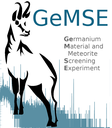 The GeMSE gamma-screening facility is used to select radiopure materials for the construction of low-background detectors for rare event searches (XENONnT, DARWIN). It is the first detector world-wide with a dedicated program to measure the cosmogenic activation of meteorites.
The GeMSE gamma-screening facility is used to select radiopure materials for the construction of low-background detectors for rare event searches (XENONnT, DARWIN). It is the first detector world-wide with a dedicated program to measure the cosmogenic activation of meteorites.
GeMSE consists of a low-background high-purity p-type germanium crystal (2.0 kg), installed in a massive shield featuring a large sample cavity of 20 liters. The detector is installed in the Swiss Vue-des-Alpes underground laboratory (620 mwe, in the Jura mountains) and is constantly used for measurements.
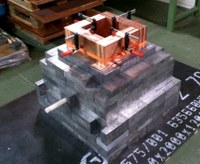
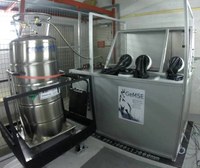
The pictures show the inner part of the GeMSE shield, which consists of low-background copper, low-background lead, and normal lead, as well as the full assembly in the underground laboratory. The shield is enclosed in a air-tight glovebox.
Have a look at the small Vue des Alpes Laboratory and GeMSE
(click on the image to start the video or use the right mouse button):
Start a timelapse movie showing GeMSE's installation in the underground laboratory by clicking on the image below (will open in new window):
Further Information on the GeMSE Facility
- M. v. Sivers et al., AIP Conf. Proc. 1672, 120004 (2015), arXiv:1505.07015.
- M. v. Sivers et al., JINST 11 P12017 (2016), arXiv:1606.03983.
- D. Ramirez Garcia et al., JINST 17, P04005 (2022), arXiv:2202.06540
Meteorite Science with GeMSE
- Å. V. Rosén et al., Meteoritics & Planetary Science 55, 149 (2020)
- Å.V. Rosén et al., Meteorit. Planet. Sci. 56, 2017 (2021)
- B.A. Hofmann et al., Journal of Archaeological Science 157, 105827 (2023)
MonXe Radon Emanation Detector
 MonXe is a sensitive detector to measure the emanation of radon atoms from the surface of materials or components. Radon and especially its radioactive daughters could lead to background in dark matter detectors.
MonXe is a sensitive detector to measure the emanation of radon atoms from the surface of materials or components. Radon and especially its radioactive daughters could lead to background in dark matter detectors.
MonXe is located in the laboratory at the 6th floor of the physics highrise in Freiburg.

Further information
- D. Wiebe, S. Lindemann, M. Schumann, JINST 19, P04014 (2024), arXiv:2309.04514
Doberman Slow Control
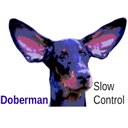
Doberman (Detector OBsERving and Monitoring ApplicatioN) is an open source slow control system for small and medium scale projects. It has been developed to operate and control the GeMSE HPGe facility as well as our LXe R&D platform in the laboratory. Thanks to its modular and flexible design, where the various instruments are read and controlled by independent plugins, Doberman can be quickly adapted for many applications, also making use of existing code or proprietary components.
The system uses a SQL database to store the data from the instruments and provides an online application to display and browse through the data. It allows the modification of device settings while the program is running and features a protocol to handle exceptions, including the automated distribution of alarm messages.
Further Information on Doberman
- P. Zappa et al., JINST 11, T09003 (2016), arXiv:1607.08189.
- The program package can be downloaded here.


